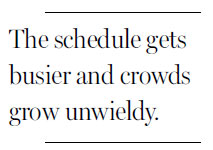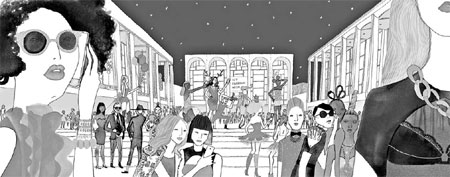Fashion Week inspires wave of irritation
Updated: 2013-09-22 07:57
By Eric Wilson(The New York Times)
|
|||||||
|
Keiko Morimoto |

Fashion Week has been around in some form or another for 70 years, but fashion people have been complaining about it for even longer.
In 1941, when the International Ladies' Garment Workers Union first invited 30 journalists to New York to visit the designer showrooms, its membership balked, not seeing how writing about clothes would help sell them. Even after Eleanor Lambert, the 20th-century cheerleader for American fashion, created the first "press week" at the Waldorf-Astoria two years later, the reporters grumbled, though their numbers grew.
"My face seems to show the lines of every silhouette that has appeared during the past 15 years," one of them groused in The New York Times. That was in 1958, when their numbers were about 200.
Fashion Week may look like the most fabulous party on earth, but insiders are getting a little tired of all the fuss. In its present form, it is more like Fashion Month, beginning September 5 with the overscheduled spring collections in New York and ending with those in Paris on October 3, with no breaks in between for the thousands of writers, retailers, photographers, videographers, bloggers and hordes of indeterminate somebodies.
Designers, too, seem to be dreading this season, and more so than usual. "It's depressing," Joseph Altuzarra said. "Well, not depressing so much as panic-inducing."
There is a curious sense that just when fashion has become a vibrant force in popular culture, attracting a new generation of designers (and those who want to be), Fashion Week is losing its relevance. Still, people have been complaining that there are too many shows for years.
But the point of Fashion Week, to promote collections to editors and retailers months before they will be in stores, is becoming lost in the age of instant online accessibility.
Add to that the resort shows, the fashion show that takes place outside the tents for the photographers, and the confused customers. All of it caused Suzy Menkes, in a column in T: The Times Style Magazine in August, to wonder, "who needs more fashion and is gagging for yet another show?"
In fact, the major events in New York, London, Milan and Paris are coming under fire from all directions. Jewish editors and retailers are upset that the New York and London shows overlap with the High Holy Days. Lincoln Center area residents are furious about the intrusion of the noisy shows and polluting generators.
Italian designers are angry that the London designers are stealing all the creative thunder, and American designers are angry the Italian designers won't budge on their show dates, forcing everyone to work on Labor Day and the Jewish holidays.
"Fashion Week needs to be rethought," said, of all people, Fern Mallis, who turned the shows into a wildly successful marketing and media event. In 1993, while executive director of the Council of Fashion Designers of America, she orchestrated Fashion Week's move to Bryant Park, where runway shows took place twice a year under enormous white tents for 15 years, establishing New York designers on par with their counterparts in Europe. The move to Lincoln Center in 2010 was heralded at the time for bringing the luster of the performing arts to fashion.
But there is little disagreement that the move has been a failure.
There are signs this season that many designers are reacting against the hype by moving to more "intimate" shows, including Mr. Altuzarra, Reed Krakoff and Oscar de la Renta. Ms. von Furstenberg surprised several designers at a fashion council meeting recently when she offhandedly remarked that a few years from now, they may all be showing digitally.
One of the most anticipated new collections this year has been that of Tamara Mellon, the former Jimmy Choo designer who is striking out on her own - and skipping the shows. Ms. Mellon received an enormous amount of attention when she declared she would introduce smaller collections throughout the year, and deliver them to stores in the season for which they were designed.
"I, for one, hate to buy a coat and not wear it for four or five months," Ms. Mellon said. "And my customer doesn't care about Fashion Week."
The New York Times
(China Daily 09/22/2013 page12)
